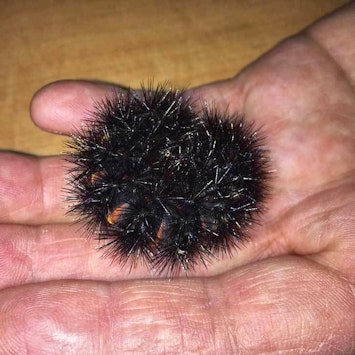Woolly Worm Wannabe
Discovery Place Nature

When fall approaches, you may see these fuzzy black caterpillars walking around. They are the larvae of the Giant Leopard Moth (Hypercompe scribonia) but are often confused with the woolly worm.
This time of year, people start looking to the woolly bear or woolly worm caterpillar for its weather "prediction." As folklore has it, the wider the brown band on a woolly worm, the milder the winter. The woolly worm is the larvae of the Isabella tiger moth.
Many folks see the Giant Leopard Moth caterpillar and mistake it for a woolly worm. This caterpillar, like the woolly worm, has stiff hairs called setae that give it a fuzzy appearance. They may look like stinging spines, but in the case of both caterpillars, they are harmless. Please note: Some moth caterpillars do have venomous spines, so it is best not to handle unfamiliar caterpillars.
These caterpillars will curl into a tight ball when touched. They spread out their shiny black spines and show bright red bands in the segments of their bodies. Called aposematism, this display of bright colors warns predators that they taste bad or can get hurt eating the caterpillar.
After danger has passed, the fuzzy caterpillar will unfurl and go on its merry way. It will spend the winter as a caterpillar, able to survive below freezing temperatures thanks to the ability to generate its own antifreeze. In the spring, it will metamorphose into a beautiful white moth with black spots and circles.

